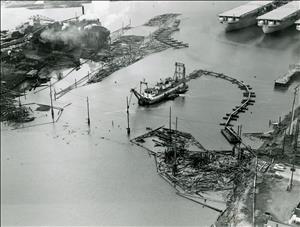On Thursday, January 23, 1997, Tacoma's Blair Bridge, located on the tideflats near the waterfront, closes and demolition begins. This bascule drawbridge spanning the Blair Waterway, along with the Murray Morgan Bridge spanning the parallel Thea Foss Waterway, had connected northeast Tacoma with downtown. The demolition follows years of controversy and public opposition, with northeast Tacomans arguing that the closing would cut them off from downtown and delay emergency vehicles and the Port of Tacoma arguing that the bridge was a barrier to further development of the port. Complicated negotiations, which included the Puyallup Tribe of Indians, shipping firms, and the City of Tacoma, resolved the issues. The day before demolition begins, an alternate route looping around the tideflats opens with the dedication of SR 509 and the new cable-stayed bridge.
Drawbridge Has Drawbacks
Bids to build what was then called the Port Industrial Waterway Bridge opened on October 20, 1951. The cost to build was $1.25 million, and the bridge (later renamed for Port Commissioner Archie Blair) opened on November 14, 1953. The span provided northeast Tacoma with a link to downtown and also provided a 150-foot-wide opening for vessels to pass through. During the 1960s, the port extended the waterway by more than a mile. Dredge material from the waterway was used to create more than 1,600 acres of land for industrial development.
Routing a thoroughfare through the busy industrial tideflats had its problems. Bridge openings stalled traffic. Over the years cargo ships became larger and had increasing difficulty negotiating the narrow opening the bridge provided. Collisions became all too frequent. In the fall of 1988 the bridge had to close for repairs for two months after a freighter smashed into it trying to pass through during a high wind. This collision by a Panamanian-flagged vessel was the eighth in 12 years. Commented Don Duncan in The Seattle Times:
"This city's vast industrial tideflats area is held together by bridges across four waterways. When one gets knocked out of commission by a large vessel — a not uncommon occurrence — businesses suffer and traffic detours test motorists' patience."
Meanwhile, the Port of Tacoma increasingly considered the Blair Bridge a major impediment to further port development.
Drawbacks to Demolition
Residents of northeast Tacoma objected to the Blair Bridge being torn down before an alternate route was in place, and in 1995, more than 150 persons showed up at a Port of Tacoma meeting concerning the bridge. Virtually all attendees opposed tearing down the bridge. Various doctors who used the bridge to get to area hospitals joined the opposition, stating that the span was essential for emergency vehicles to arrive at hospitals in a timely manner. In 1995 the port commission was itself split, and the opposition threatened to oppose the elections of three port commissioners (Mike Fletcher, Jack Fabulich, and Steve Anderson), who were up for re-election and who supported the demolition of Blair Bridge.
In September 1995, the Port of Tacoma, along with WSDOT, began holding public meetings to discuss the changes along Blair Waterway. Represented at the meetings were the port-area business community; the Northeast Tacoma Neighborhood Council; the Tacoma Transportation Committee; the Tacoma City Council; WSDOT; and the Puyallup Tribe of Indians, a major stakeholder along Blair Waterway.
During the 1980s the Puyallup Tribe had negotiated with various governmental bodies concerning its traditional lands around the tideflats and Commencement Bay. In 1990 a settlement was concluded in which the tribe received $162 million in cash, real estate, and economic development programs in exchange for giving up claims to about 18,000 acres along Commencement Bay. The tribe planned to move its casino to a new location away from the vicinity of Blair Waterway and to build a container port in its place. The tribe contributed to the cost of building SR 502 and the cable-stayed bridge.
Meanwhile, the Port of Tacoma also negotiated with two of its major shipping customers, Maersk, Inc., a Danish firm, and Evergreen America Corp, a Taiwanese shipping line, so that Evergreen could expand into 10 acres of Maersk's land. This enabled Evergreen to expand without moving across E 11th Street, which would have required demolishing the bridge before the alternative was completed.
The various parties agreed to delay the demolition of the Blair Bridge until the new route that looped around the tideflats (which included the new cable-stayed bridge) was in place. The Port of Tacoma compensated several restaurant establishments that had done a brisk business serving lunch to tideflat workers who got there by walking across Blair Bridge.
Clearing the Way
Bridge demolition, managed by WSDOT, was carried out by the contractor A. H. Powers of Seattle. As soon as demolition began, the Port of Tacoma began dredging and widening Blair Waterway.
In April 1997, the Port of Tacoma signed a 30-year lease with Hyundai Merchant Marine for a new terminal on the upper Blair Waterway. This $100 million, 60-acre terminal opened in May 1999. In January 2003 the Port of Tacoma and Evergreen America signed an agreement involving an enormous expansion of Evergreen along with a move from the mouth of Blair Waterway to its head.
Thus the removal of the old but not really historic Blair Bridge cleared the way for the Port of Tacoma to become an even more important center of commerce in the state of Washington.

